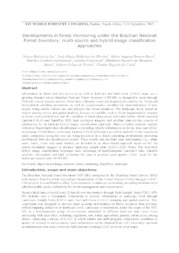Developments in forest monitoring under the Brazilian National Forest Inventory: multi-source and hybrid image classification approaches.
Developments in forest monitoring under the Brazilian National Forest Inventory: multi-source and hybrid image classification approaches.
Author(s): LUZ, N. B. da; OLIVEIRA, Y. M. M. de; ROSOT, M. A. D.; GARRASTAZU, M. C.; MESQUITA JÚNIOR, H. N. de; FREITAS, J. V. de; COSTA, C. R. da
Summary: Information on forest and tree resources as well as land use and land cover (LULC) maps are a growing demand which Brazilian National Forest Inventory (NFI-BR) is designed to meet through field and remote sensing surveys. Field data collection comprises biophysical variables for forest and environment condition assessment, as well as socioeconomic variables for characterization of how people living nearby forests use and perceive the forest resources. The landscape level, based on remote sensing survey and spatial analysis, focuses on variables such as forest fragmentation, changes in forest cover and land use, and the condition of forest along rivers and water bodies. Multi-temporal Landsat-8 (L-8) and RapidEye (RE) high resolution imagery and ancillary data are the sources of information for an intricate hybrid image classification approach. Object-oriented analysis coupled with pixel based multi-data classification is providing reliable information on forest, trees and LULC monitoring. Global forest cover data, Landsat-8 TOA reflectance as well as derived 32-day vegetation index composites along the year are being processed in a cloud computing environment, providing pixel-based 30m pre-classification results. These results and ancillary map information (i.e., urban areas, roads, rivers and water bodies) are included in an object-based approach based on RE 5m spatial resolution imagery to produce landscape sample units (LSU) LULC Maps. The described hybrid image classification technique takes advantage of multi-temporal Landsat-8 data, valuable ancillary information and high resolution RE data to produce good quality LULC maps for the landscape sample units of NFI-BR.
Publication year: 2015
Types of publication: Paper in annals and proceedings
Unit: Embrapa Forestry
Observation
Some of Embrapa's publications are published as ePub files. To read them, use or download one of the following free software options to your computer or mobile device. Android: Google Play Books; IOS: iBooks; Windows and Linux: Calibre.
Access other publications
Access the Agricultural Research Database (BDPA) to consult Embrapa's full library collection and records.
Visit Embrapa Bookstore to purchase books and other publications sold by Embrapa.

